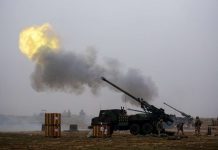
A new Hudson Institute report suggests that Ukraine could severely weaken Russia’s military power by striking eight critical targets inside Russian territory. According to U.S. analysts, combining drone and missile strikes with selective ground operations could break the current stalemate and reshape the course of the war.
The report, written by Luke Coffey and Can Kasapoğlu, outlines “eight high-value, realistic targets” that would both undermine Russia’s military operations and raise the costs of its continued occupation of Ukraine. While no single strike would be decisive, the authors argue that sustained attacks on multiple points could seriously disrupt Russia’s ability to wage war.
Among the targets is the Volga-Don Canal, a 63-mile waterway linking the Caspian and Black Seas. The canal allows Russia to move ships into the Black Sea and enables Iran to deliver weapons. Although damaging its 13 locks would require highly precise, powerful warheads, success would carry major geopolitical consequences for both Moscow and Tehran, the report notes. Interrupting traffic through the canal would also slow or stop commercial and military shipping, inflicting economic harm.
The study also highlights a joint Russo-Iranian drone plant in Tatarstan, which produces Shahed drones used against Ukrainian cities. While the facility itself is difficult to destroy outright, its dependence on the regional power grid makes it vulnerable. Strikes on the Nizhnekamsk Thermal Power Plant or other parts of Tatarstan’s energy network could halt production.
Russia’s trade with China was also flagged as a weak point. Around 60% of rail shipments between the two countries cross at Manzhouli–Zabaykalsk and Suifenhe–Pogranichny. Although the authors caution against direct action on Chinese territory, they identify several vulnerable chokepoints within Russia near these crossings.
Crimea remains a major logistical hub. Beyond the Kerch Bridge, already targeted by Ukraine, the Chonhar, Syvash, and Henichesk bridges also serve as vital supply routes. The report recommends that Western allies provide Ukraine with precision weapons such as Germany’s Taurus missile to destroy or disable these connections.
Rail infrastructure in Russia’s Western Military District is another priority. Since Russia depends heavily on trains for troop and equipment movements, destroying bridges, transformers, and substations could create cascading delays and secondary vulnerabilities across the network.
The report also points to Russia’s efforts to shift its Black Sea Fleet to Ochamchire in Abkhazia after losses in Crimea. The new base remains under construction and within Ukrainian drone range, making it an attractive target that could deliver both strategic and symbolic gains.
Even Russia’s faraway Pacific Fleet bases are mentioned. Though striking Vladivostok—6,000 miles from Kyiv—would be challenging, the authors suggest Ukraine could deploy containerized drones from disguised cargo ships. Such strikes, even if only partially successful, could force Russia to reconsider how it defends naval assets worldwide.
Finally, the report considers Transnistria, a breakaway Moldovan region with about 1,500 Russian troops. Capturing this isolated enclave could relieve pressure on Odessa and give Ukraine leverage over the Kremlin. However, with Ukraine’s forces stretched thin in the east, such an operation would be the most difficult to mount.




